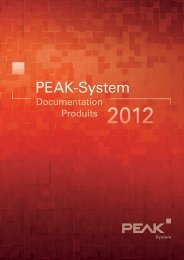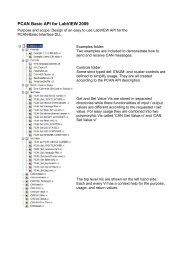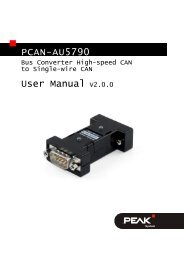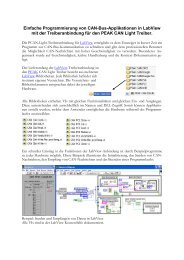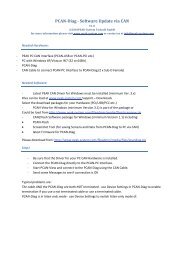1 PLIN-API Documentation - PEAK-System
1 PLIN-API Documentation - PEAK-System
1 PLIN-API Documentation - PEAK-System
Create successful ePaper yourself
Turn your PDF publications into a flip-book with our unique Google optimized e-Paper software.
3.3 The LIN Frame Entry <strong>PLIN</strong> <strong>API</strong> <strong>Documentation</strong><br />
always from the first entry of the table. While the schedule is being worked out, it is not possible to send frames using the<br />
function LIN_Write ( see page 115).<br />
• LIN_SuspendSchedule ( see page 136): This function is used to stop processing a Schedule Table. While the<br />
processing of the schedule is suspended, it is possible for a client application to send frames using the function LIN_Write<br />
( see page 115).<br />
• LIN_ResumeSchedule ( see page 136): This function is used to resume the processing of a schedule which was<br />
suspended before. The process start at the point where it was stopped.<br />
Reading<br />
The client can get messages received by the Master. If a received message meets the configured filter of a client (the filter<br />
allows the message to pass through), the Master stores the message in the receive queue of the client. From there the<br />
messages can be read, using the functions LIN_Read ( see page 114) and LIN_ReadMulti ( see page 114).<br />
Writing<br />
Basically, the master can operates in two states:<br />
Scheduler Suspended<br />
A client application connected to the Master sends data frames using the function LIN_Write ( see page 115). The calling<br />
of this function determines the timing behavior on the bus. The values and options of the message passed to the function<br />
control the data flow.<br />
Scheduler Running<br />
The timing behavior on the bus is provided by the current Schedule Table. The values and options of the Frame Entries<br />
Table control the data flow. The Frame Table determines how the Slave responses to an ID. While the Master is running is<br />
not possible to directly send messages to the LIN bus using the function LIN_Write ( see page 115).<br />
The Frame Table will be used to control the data flow, because the Schedule Table does not contain any information about<br />
frame lengths or directions. All configurations of a Frame Entry, with exception of the Single Shot flag, can be used to<br />
configure the frames. The configuration of the Frames is done using the function LIN_SetFrameEntry ( see page 125) and<br />
LIN_GetFrameEntry ( see page 126). The data sent from a Master, as Publisher, will be updated on the hardware using<br />
the function LIN_UpdateByteArray ( see page 127).<br />
See Also<br />
LIN_InitializeHardware ( see page 116) (.NET: InitializeHardware ( see page 64))<br />
LIN_GetStatus ( see page 139) (.NET: GetStatus ( see page 95))<br />
LIN_Write ( see page 115) (.NET: Write ( see page 63))<br />
LIN_SetSchedule ( see page 130) (.NET: SetSchedule ( see page 86))<br />
LIN_StartSchedule ( see page 135) (.NET: StartSchedule ( see page 91))<br />
LIN_SuspendSchedule ( see page 136) (.NET: SuspendSchedule ( see page 92))<br />
LIN_ResumeSchedule ( see page 136) (.NET: ResumeSchedule ( see page 92))<br />
LIN_SetFrameEntry ( see page 125) (.NET: SetFrameEntry ( see page 81))<br />
LIN_UpdateByteArray ( see page 127) (.NET: UpdateByteArray ( see page 83))<br />
3.3 The LIN Frame Entry<br />
A LIN Frame Entry (represented by the structure TLINFrameEntry ( see page 29)) is used to configure the LIN Table. This<br />
table contains 64 entries, from ID 0 to ID 63. When a hardware is configured as Slave (slave-mode), the entries in the LIN<br />
Table determine how the hardware behaves, when a LIN Master sends a header with a determined ID.<br />
10<br />
3



![English - Low Quality [7.2 MB] - PEAK-System](https://img.yumpu.com/5931738/1/184x260/english-low-quality-72-mb-peak-system.jpg?quality=85)
